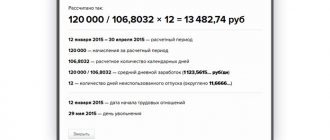After maternity leave, a woman who has become a mother usually goes on a longer leave to care for her child. It can be interrupted at any time and work can continue on the same or preferential terms for the mother. The administration is obliged to reserve for a woman on maternity leave her workplace and position. The law prohibits interfering with a woman’s desire to simultaneously work and raise a child under 3 years of age. Our material will tell you how to formalize your exit from maternity leave without waiting for the end, what are the features and consequences of such a decision.
Exiting maternity leave: what you need to know
A woman’s right to maternity leave is enshrined in the Labor Code of the Russian Federation, Art. 256. It can be used in whole or in part. Most often, the woman herself goes on maternity leave, but other family members also have the right to maternity leave to care for a child up to 3 years old, with all the rights and responsibilities arising from the law.
Vacation is not prohibited from being shared between relatives. A woman can go to work ahead of schedule, and the remainder of the maternity period will be used by the child’s relatives to care for him.
Important! Care leave is given, on an equal basis with biological parents, to adoptive parents and members of their family on the same conditions (Labor Code of the Russian Federation, Article 257).
The legislator talks about a vacation of up to 3 years, but in fact it is divided into 2 parts:
- up to 1.5 years, when care benefits are paid from the Social Insurance Fund;
- from 1.5 to 3 years, when a small compensation payment comes from the employer’s funds.
Compensation today is only 50 rubles. per month. It is during this period that workers most often interrupt maternity leave.
The employer is obliged to preserve the employee's job. If difficulties arise with this, he can transfer a woman who has left her leave early to another position only with her consent. The administration also does not have the opportunity to fire her on its own initiative. The only reason for dismissal is liquidation of the company.
If a woman wants to both work and use benefits for up to 1.5 years, she is given a schedule for a part-time working week (day), taking into account the maximum standard working time - 40 hours per week (Article 91 of the Labor Code of the Russian Federation).
The duration of working hours must be fixed in the contract, and the transition to part-time work must be reflected in the additional agreement to it.
Part-time work is provided to a woman up to 1.5 years of age along with the payment of benefits (Article 93, paragraph 2, Article 256, paragraph 3 of the Labor Code of the Russian Federation), after which she will be required to work as usual. This rule applies even if the woman’s working day was reduced minimally, for example, by one hour a day. By analogy with part-time work, a woman has the right to work from home without losing her right to benefits.
Attention! If she goes back to work full-time, the payment of benefits and compensation for a child under 3 years of age stops.
Vacation pay after maternity leave, calculation and payments in 2019-2020
Employees working officially under an employment contract are provided with paid leave. According to Article 115 of the Labor Code of the Russian Federation, the maximum duration of rest is 28 days. When calculating vacation pay, an accountant must take into account many nuances. This also applies to calculating leave after maternity leave.
How are vacation pay calculated after maternity leave?
Each employee can take paid leave after 6 months of work. You can go on vacation before the end of six months by agreement with your employer. The vacation schedule is drawn up taking into account the wishes of the employees of the department or other unit.
The schedule is approved by management. Without observing this schedule, a woman who plans to return from maternity leave has the right to take official leave. By agreement with the employer, she can take leave before or after maternity leave.
This procedure is also possible if she has already taken annual leave. The employer in this situation provides her with rest in advance, that is, for the next reporting period.
If a woman was on vacation, granted to her in advance, and then decided to leave her job, part of her vacation funds is deducted from her dismissal payments.
Calculation of annual leave after maternity leave occurs in the standard way. The algorithm of actions is specified in Article 139 of the Labor Code of the Russian Federation. When calculating, you need to correctly determine the following indicators:
- number of vacation days;
- billing period;
- average annual earnings;
- vacation pay.
According to the provisions of the Labor Code of the Russian Federation, a woman who has returned from maternity leave has the exclusive right to receive annual leave immediately.
She must be given a vacation period of 28 days; in some situations, these days can be extended in time, but not reduced.
In addition, when calculating the allotted rest time, days unused before maternity leave, accrued to the woman before going on sick leave for pregnancy and childbirth, can be taken into account.
The number of days of annual leave is calculated as follows:
- Vacation days unused by the employee before maternity leave are calculated.
- The days due for sick leave lasting 140 days are calculated.
- The amounts add up to each other.
The duration of maternity leave is 140 days, which corresponds to 4 months and 20 days. These days are rounded up to 5 months. With an annual leave duration of 28 days, 2.33 days are allotted for each month. We multiply this figure by 5, it turns out 11.65 days. Typically, the employer rounds these days to 12.
In the process of calculating the money a woman is due for her vacation, you need to pay attention to the billing period. According to the Labor Code of the Russian Federation, the billing period is 12 months. This year precedes the annual vacation period.
An employee who returned to work after maternity leave without working for 140 days, which were provided to her by law and up to 3 years to care for an already born child.
The actual duration of a woman’s maternity leave depends on the nature of the birth and the number of children born.
Sick leave for pregnancy and childbirth is included in the billing period. Does not include parental leave. Based on this, when calculating average earnings, payments accrued to the employee’s bank account during this time are taken into account.
If, after the expiration of the sick leave, a woman immediately went to work, then she does not have any excluded periods. Therefore, the calculation period is 12 months before the month of registration of the annual paid vacation.
If a woman did not return to work after 3 years, that is, after maternity leave, then she had no income in the previous year. Therefore, the calculation should be based on the 12 months preceding the start of her maternity leave.
The amount of average earnings per day also plays an important role in the process of calculating vacation pay. The calculation of average earnings includes the following indicators:
- the amount of salary that was received during the billing period;
- bonuses, allowances, surcharges.
IMPORTANT: If the company has increased salaries, then indexation is carried out.
Income not subject to accounting:
- vacation pay;
- one-time bonuses;
- payment for business trips;
- one-time benefits;
- subsidies;
- prizes received as a result of winning competitions;
- bonuses that were paid to employees for the holiday;
- benefits for caring for a disabled child.
The calculation procedure is standard. The amount of income for the billing period is determined. All accrued indicators are added up. The number of days actually worked by her is determined.
If the month is worked in full, then the number of days is equal to the coefficient 29.3.
If the month is not fully worked, then the number of days is calculated as calendar days worked, which are divided by the total number of calendar days, multiplied by 29.3.
Formulas for calculation:
Average earnings = income / number of full days X 29.3 + number of days in partial months
Calculation of vacation pay for annual holidays:
Vacation pay = average earnings X days of vacation
Example
Source: https://trudinspection.ru/alone-article/dekretniy-otpusk/otpusknye-posle-dekreta-raschyot-i-vyplaty/
How to register for work
It is necessary to register for early return to work on the basis of an application. It is expected that the woman will inform about her decision in advance so that the administration has the opportunity to solve the problem of personnel changes and possible dismissals (as a rule, another employee works in the employee’s place until she returns from vacation).
The legislation, however, does not contain any deadlines that should guide the parties in this case. It is advisable to register them in the LNA and familiarize them with the employees against their signature.
The application is written in free form. It reflects a request to interrupt parental leave. If the employee returns to full-time work, a request is made to interrupt the payment of benefits for up to 1.5 years. If a woman starts working part-time or intends to work remotely while receiving benefits, the request to interrupt parental leave is not included in the application.
This wording may serve as a reason for refusing a company compensation for payments for a child, since Art. 256 of the Labor Code of the Russian Federation speaks of part-time work and home work “while on parental leave.”
An additional agreement to the employment contract is drawn up, which states:
- for how long working hours are reduced or home-working is established;
- for how long these conditions will apply;
- how payment will be made.
Based on the application, an order is issued from the manager regarding the woman’s return from maternity leave to a certain position. Its operating mode must be indicated. At the same time, the order may contain a clause regarding the dismissal of an employee hired to replace a woman who has returned from leave. If one of the employees was transferred to this position, a clause on the return transfer to the previous position is added to the order.
If maternity payments stop after leaving leave, this is also reflected in the order. Parental leave, including early exit from it, is entered into a personal card. There is no need to make any entries in the work book.
How to calculate average earnings after parental leave?
The employee returned to work from maternity leave for up to three years and was about to take her annual paid leave.
How to calculate vacation pay? We take into account the salary for the period from April 2007 to March 2008. The salary for this period is 38,290 rubles. 36 kopecks From this period we subtract sick days.
In 2007, the employee’s salary was 4,000 rubles, in 2008 - 5,500 rubles. Is it necessary to display the coefficient since there was a salary increase? Do I need to multiply the average salary by the increase factor? This year, the employee’s salary increased to 7,500 rubles.
Billing period
When calculating the average earnings retained by employees during the period of annual leave, the rules established by the Regulations on the specifics of the procedure for calculating average wages[1] (hereinafter referred to as the Regulations) are applied.
In general, the average daily earnings for vacation pay are calculated based on the billing period, which includes 12 calendar months preceding the month the vacation began (clause 4 of the Regulations).
In the case under consideration, we are talking about an employee who, during the billing period, was on maternity leave for a child under three years of age and returned to work shortly before the start of her annual leave. In this case, options are possible.
Option 1. The employee returned from maternity leave in one month (for example, in June 2011), and is granted annual leave in the next month (in July 2011).
In this case, the billing period is determined according to the general rules: it includes 12 calendar months (from July 2010 to June 2011, of which days worked are available only in one - the last month (June 2011).
Average daily earnings for vacation pay are determined by dividing the amount of wages accrued for days worked in the billing period (in June 2011) by the number of calendar days falling on the period worked, calculated using the formula:
29.4 / Km × (Km – Ko),
where 29.4 is the average monthly number of calendar days;
Km - the number of calendar days of the month of the billing period (in June - 30 calendar days);
Ko - the number of calendar days during which the employee was released from work (was on maternity leave).
For example, if an employee went to work on June 23, then the number of calendar days included in the calculation of average earnings will be:
29,4 / 30 × (30 – 22) = 7,84,
where 22 is the number of calendar days falling on parental leave (from June 1 to June 22).
Option 2. Annual paid leave is granted to the employee in the same month in which the maternity leave ends.
This situation falls under clause.
6 of the Regulations, according to which, if the employee did not have actually accrued wages or actually worked days for the billing period or for a period exceeding the billing period, or this period consisted of time excluded from the billing period in accordance with clause 5 of the Regulations, average earnings determined based on the amount of wages actually accrued for the previous period, equal to the calculated one.
Thus, the calculation period will be recognized as 12 calendar months preceding the start of maternity leave. For example, if maternity leave was granted to an employee from April 2008, then the calculation period will include the months from April 2007 to March 2008.
Months of the billing period in which the employee was released from work with full or partial retention of pay (was on vacation, on business trips, was sick, etc.
) or without pay (was on leave without pay), are considered not fully worked.
The number of calendar days included in the calculation of average earnings in months not fully worked is determined in the manner indicated above.
Increase factor
As follows from the question, from January 1, 2008, the employee’s salary was increased from 4,000 rubles. up to 5,500 rubles, and from January 1, 2011 - up to 7,500 rubles.
In accordance with clause 16 of the Regulations, when tariff rates, salaries (official salaries), and monetary remuneration increase in an organization (branch, structural unit), the average earnings of employees increase.
NOTE! Average earnings are adjusted if the salary increase affected all employees of the organization. If the specified increase was of an individual nature, for example, it was associated with the transfer of an employee to a new position, the expansion of her job responsibilities, or was of a stimulating nature, then the average earnings are not adjusted.
Let's assume that the salary increase took place throughout the organization. Then adjust:
• payments accrued for the months of 2008 included in the billing period (from January to March), by an increase factor of 1.363 (7,500 / 5,500);
• payments accrued for the months of 2007 (from April to December), by an increase factor of 1.875 (7,500 / 4,000).
In this case, not all payments are adjusted, but only tariff rates, salaries, monetary remuneration and payments established to tariff rates, salaries (official salaries), monetary remuneration in a fixed amount (interest, multiple).
These payments include additional payments and allowances for working conditions that deviate from normal: for work in difficult, harmful and dangerous working conditions, for work at night, etc.
Any payments the amount of which is set in a range of values (percentage, multiple) to tariff rates, salaries, as well as payments set in absolute values are not subject to adjustment.
Thus, premiums are usually set within a range of values.
For example, if the salary regulations (bonus regulations) indicate that the monthly bonus is accrued in the amount of no more than 30% of the salary, then it is considered that the bonus amount is set in the range from 0 to 30%. It does not matter that the bonus is actually accrued for each month in the same amount - 30% of the salary.
Premiums can also be set in absolute values. For example, by order of the head of the organization, all employees are paid certain amounts that are not “tied” to tariff rates or salaries.
Thus, from January 1, 2008, all payments accrued in the billing period related to bonuses and the like will not be adjusted to the salary increase factor from January 1, 2008.
Source: https://www.profiz.ru/kr/9_2011/kak_pascitat_sred_zarabot/
Legal aspects and examples
Let's look at the procedure for early exit from parental leave using several typical examples.
Situation: the employee is going to leave maternity leave, which she informed the management about by writing a corresponding statement. The administration told her that there were no available jobs and offered her to resign.
Here the administration violated the provisions of Art. 256 of the Labor Code of the Russian Federation, which talks about guarantees of maintaining a job during parental leave. It is advisable to first identify the violation by contacting the labor inspectorate or the prosecutor's office with a request to verify the legality of the administration's actions, and then, guided by the collected materials, go to court.
Situation: the director informs an employee who is on maternity leave for up to 1.5 years that the company is being liquidated (the name is being changed), offers to leave the leave early, resign on her own initiative, and then come to work at a new company.
In this situation, leaving the vacation early and subsequent dismissal with the conclusion of a new employment contract is unprofitable for the employee. Renaming a company does not mean its automatic liquidation. In addition, dismissal during liquidation involves a number of guarantees and compensations, including for women on maternity leave.
Situation: a woman is caring for a child under 1.5 years old, is on vacation, and wants to terminate it early. Then the baby’s father, an employee of the same organization, is going to register it. Parents act within the framework of Art. 256 of the Labor Code of the Russian Federation, which talks about the possibility of using leave not only by the mother, but also by other relatives and parts. The mother must write a letter of resignation, and the father must write a letter of resignation. Based on these documents, personnel orders are issued and benefits are calculated.
Situation: a woman’s maternity leave is expiring for up to 1.5 years, she wants to continue using the leave by filling out an application and extending it to 3 years, but in fact she is going to start working earlier. If previously the employee wrote an application for leave for up to 1.5 years, now she needs to write a new one - up to 3 years, and then, having worked for the desired period, declare in writing that she is leaving the leave. Based on the application, a corresponding order is issued.
The maternity leave has ended, what are the next steps?
The day on which you need to begin work duties after a three-year vacation is indicated in the vacation order. This is the first working day following the day your baby turns three. It's not difficult to remember. Therefore, in this case, there is no need to write any statement after maternity leave. But many employers try to play it safe and still require an application, even when the employee leaves on time.
We recommend reading: Documents Tax Refund on Mortgage Interest
Briefly
- An employee caring for a child under 3 years old can leave maternity leave earlier than the specified period. To do this, she should write an application for early termination of vacation. The consent of the company's management is not required.
- Working at a wage ahead of schedule means that she is not entitled to benefits paid until the child is 1.5 years old, and a reduced schedule and home work allow her to benefit from social support from the state in full.
- If a woman starts working ahead of schedule, any member of the child’s family can take leave instead.
If you need to call an employee from maternity leave
In a resolution dated October 28, 2008 in case No. A31-357/2008-7, the FAS of the Volga-Vyatka District concluded that a pregnant woman can continue to work as long as it does not pose a danger to her health. But, of course, she should already have a sick leave. But here another problem arises: a woman cannot receive both benefits and a salary at the same time. The Social Insurance Fund has the following opinion on this matter: employees who submitted an application later than the date specified in the certificate of incapacity for work receive benefits based on the remaining number of days of maternity leave. It turns out that the duration of the maternity leave may not coincide in date with the certificate of incapacity for work.
We recommend reading: How to Transfer a Share in a Privatized Apartment to a Relative
If you are not welcome at the workplace
This is a painful question for any woman. Plans to return to your previous workplace may be destroyed in a moment. A mountain of questions are scrolling through my head, only increasing my fear.
Mothers should calm down - the law supports them. The Labor Code states that a boss cannot fire a girl who is on maternity leave. In addition, he must provide the position and salary as before the maternity leave. In this case, demotion in position is not allowed.
How does the Labor Code regulate the issue?
While an employee is on maternity leave, the following could happen:
- the position was taken by a temporary employee whom the employer does not want to transfer to another position or dismiss;
- the division in which the employee worked before the maternity leave ceased to exist, that is, the staff was reduced, but the entire enterprise was not liquidated;
- the company was liquidated.
When a company is liquidated, any employee can be fired, including those on maternity leave. However, in all other cases, an employee on maternity leave cannot be fired. This rule is enshrined in Part 6 of Art. 81 Labor Code of the Russian Federation.
To transfer an employee who has returned from maternity leave to a new position or another job, his voluntary consent is required. Otherwise, he should be given his previous position. Dismissal can only be made for disciplinary violations.
At the same time, employees often forget that, by virtue of Art. 72.1 of the Labor Code of the Russian Federation, the employer can transfer them to another workplace in another unit in the same area. The main thing here is that the terms of the employment contract do not change. Employers take advantage of this condition if another permanent employee returns to work during maternity leave.
Let me give you an example from practice: before going on maternity leave, a woman worked as an administrator in a private medical clinic, which had two divisions located in two different buildings. After the child turned 3 years old, the woman decided to go to work.
The employer refused to give her her previous job, but offered her a job as an administrator in a nearby dental department. The woman didn’t want to work there: she didn’t like the fact that she would have to work with money. Since she did not show up for work, her employer fired her for absenteeism. The court recognized this as legal (see the decision of the Borovsky District Court of the Kaluga Court of January 30, 2019 in case No. 2-113/2019).
If at the time of maternity leave the position was reduced, then, according to Art. 81 of the Labor Code of the Russian Federation, the employee must be offered another job available to the employer, even if it is paid less. If he does not agree, he may be fired, and the employer, as in the case of liquidation of the company, must pay his former employee severance pay and support him financially during his employment.
According to Art. 180 of the Labor Code of the Russian Federation, an employee dismissed during liquidation or layoff has the right to receive his previous earnings for up to 3 months until he finds a new job. To receive payments for the 3rd month, you will have to register with the employment center immediately after dismissal.
Remember - when an employee returns from maternity leave, the employer cannot:
- not provide him with his previous job;
- transfer to another position without obtaining prior consent;
- suddenly and out of turn to recertify an employee returning from maternity leave.
If the employer cannot immediately provide the previous workplace, he must pay for the downtime. It is important here that the employee who has returned from maternity leave is at the enterprise or office during working hours. Absence may be counted as absenteeism and result in dismissal.
An interesting point: the position from which the employee went on maternity leave is not vacant at the enterprise. That is, she should not be offered to replace other employees who have been laid off. The courts pay attention to this (see the decision of the Pervomaisky District Court of Vladivostok dated February 13, 2019 in case No. 2-3072/2018).
In case of possible difficulties and obstacles on the part of the employer, you can file a complaint against him with the labor inspectorate. The regulatory authorities are on the side of the employee, so the employer will receive a warning about the need to comply with the requirement of the law or a fine under Art. 5.27 Code of Administrative Offenses of the Russian Federation. A fine can be imposed both on the company itself and on the director personally.
The liquidation of an enterprise is an exceptional case in which the contract is terminated without the consent of the employee, but a settlement must be made with the employee according to all the rules.
In practice, there may be no settlement if the company is subject to bankruptcy proceedings and there is no money in the accounts. But even in this case, debts to employees must be repaid over time.
Children's status in the team
A big burden for a mother is the illness of her child. Especially during periods of busy work. Practice shows that male bosses are more loyal to such situations.
Practical advice
Have an honest conversation with your employer about the current problem and find solutions together. There is no need to show that nothing is important except leaving - this will not work. It may be possible to do part of it at home or switch to remote mode during illness. In what cases can you “break out” to the child, and in what cases should you act differently? There will always be a solution, the main thing is to correctly explain the problem.
How yesterday's maternity leavers can build relationships with their bosses
The main concern of managers is the endless “times off” from work and frequent sick leave for young mothers. This tension on the part of the employer can be reduced by a “reliable back” in the person of a nanny, grandmother or someone who can insure a working mother in such situations. The less often your boss remembers that you just returned from maternity leave, the better for your career.
This does not mean at all that bosses are heartless: they also have small children, elderly parents, running taps in the kitchen and all other family and household issues. But their task is to provide you with a timely salary, which means efficient organization of the work process.
If you have no plans to return to work
What to do if you don’t want to go to your previous place? Usually girls worry about how to get back. But this question is also important.
Experts talk about the right approach to this moment. Bringing a piece of paper and handing it to your superiors is not the best idea. Therefore, there are a number of ways to “smooth out” this process:
- There is no need to delay the decision - management should be informed in advance. This way, the boss can find a replacement in time and won't be discouraged.
- A personal meeting is the best method. If, along with the application, a woman comments on her decision and tells the reasons, it will be professional. In addition, handing over the paper for settlement and “hiding” is a bad human sign.
- Feelings of guilt towards the administration and colleagues should be driven away. If a girl feels like she is letting the team down, this is self-hypnosis. The work was carried out without her, and dismissal will not cause the collapse of the entire process.
When returning to your previous workplace after maternity leave, you should understand that now many things have changed, and the routine that has been customary for so many years needs to be changed. This is not her fault. But judging everyone around is not a good idea. The maximum that this will lead to is conflicts at work or, even worse, in the family.
Changes should start from within. Develop strength and confidence. With enough persistence, this is a completely doable task. Such qualities allow a woman to become not only an excellent mother, but also a successful worker.







